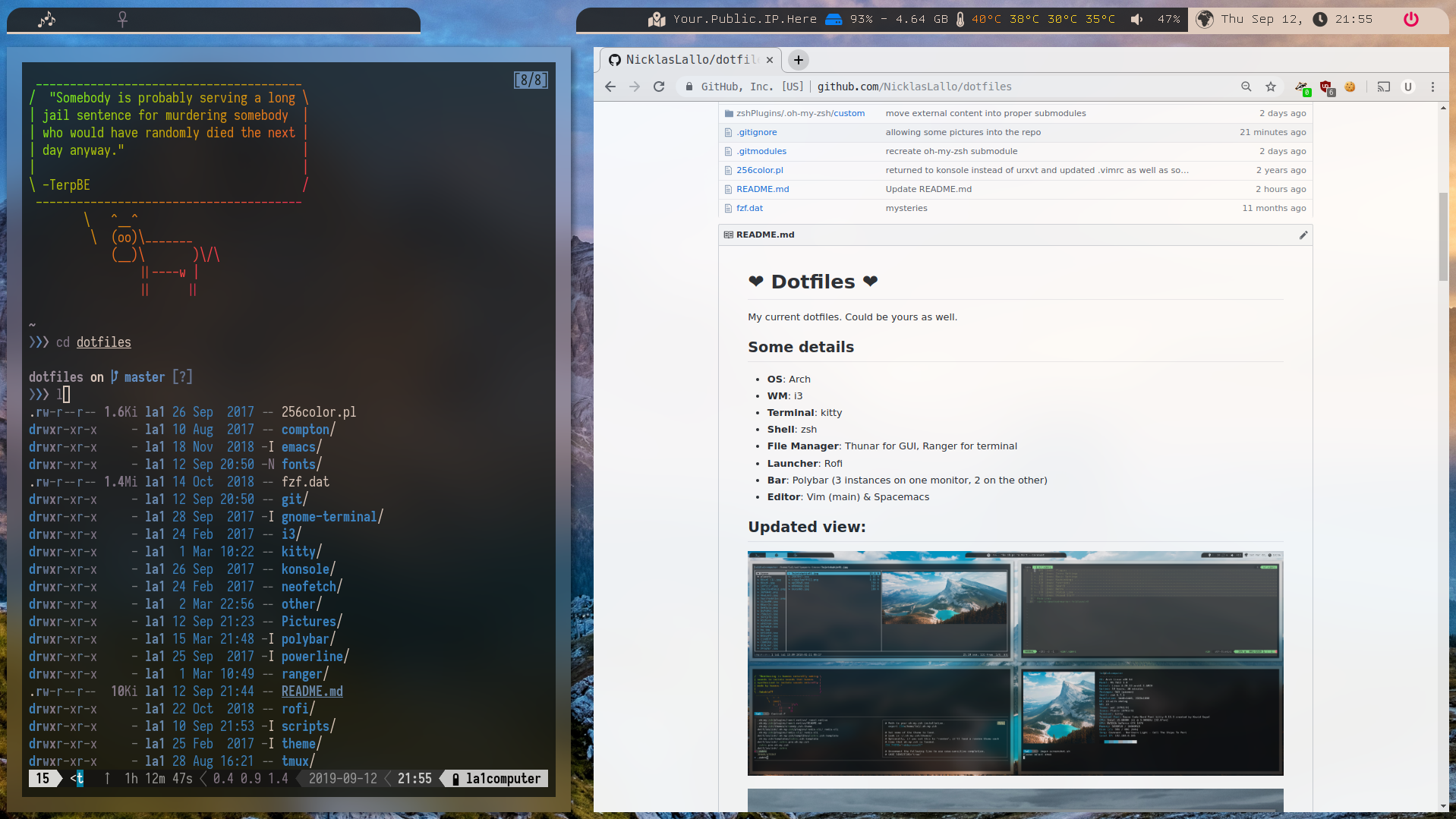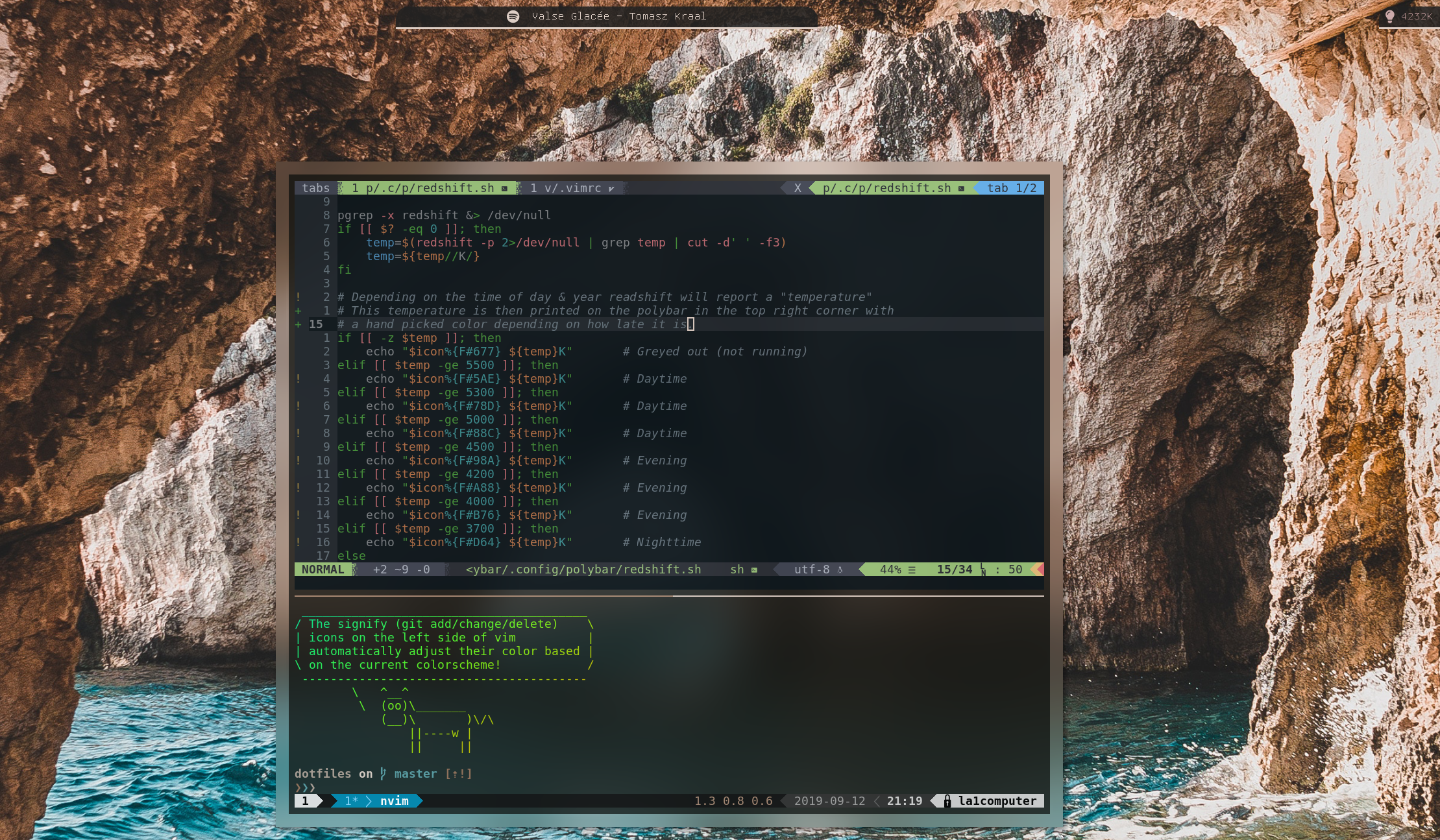My current dotfiles. Could be yours as well.
- OS: Arch
- WM: i3
- Terminal: kitty
- Shell: zsh
- File Manager: Thunar for GUI, Ranger for terminal
- Launcher: Rofi
- Bar: Polybar (3 instances on one monitor, 2 on the other)
- Editor: Vim (main) & Spacemacs
 Vim running in a floating terminal windows with the Iosevka font. It supports ligatures and all powerline & nerdfont symbols.
Vim running in a floating terminal windows with the Iosevka font. It supports ligatures and all powerline & nerdfont symbols.
 More common 1080p monitor. Every time a new terminal is opened you get a fresh showerthought quote presented to you buy a rainbow cow.
More common 1080p monitor. Every time a new terminal is opened you get a fresh showerthought quote presented to you buy a rainbow cow.
 With Redshift disabled (evening)
With Redshift disabled (evening)
 Different background and Vim colortheme.
Different background and Vim colortheme.
 This picture isn't quite accurate any more.
This picture isn't quite accurate any more.
You can easily pick and choose the parts you like without having to use everything. Each folder is named after a package and contains every configuration file used by that application. The files inside the folders are relative to home (e.g. the file vim/.vimrc goes to ~/.vimrc).
Since these are dotfiles they obviously require you to also install the original software you want these files to configure for you, they are after all only the configuration files.
To more quickly set things up I recommend to use GNU Stow to symlink the dotfiles.
- Clone the repo into your home folder, e.g.
~/dotfiles. - Install stow from your package manager. (or do the symlinks manually, see:
man ln) - Backup any of your original config files you want to keep around.
- Download the submodules (additional git repos) with
git submodule init&git submodule update. - Go to the repo and run
stow vimor similar to symlink the files associated with that part of the setup.
My setup uses two monitors, one of which is an ultrawide monitor with an unusually high resolution (3440x1440). If you use this on any other system you will have to manually tweak the positioning of the polybar segments. This is not difficult, simple math should suffice. Same with the gaps/borders, they are most likely to large on for example only a single 1080p or 720p monitor. The i3 config file also says wich workspace should go on which monitor (use xrandr to find the names of your monitors).
Also, even though I intend for these configuration files to be modular and somewhat independant, I still highly recomend that you read through every file before you use it. Who knows what I might have included in here.
In order to not copy others' repos into this repo some things such as oh-my-zsh are included in the form of submodules. This means that after you git clone this repo you will need to also run git submodule init and then git submodule update.
Some other things that could be submodules aren't at the moment, such as some fonts or small scripts. That might change in the future.
Many of the dotfiles require additional software/plugins or such that aren't imediately obvious, for example extra fonts, or other programs that don't require their own dotfiles, I have tried to document those in this file but I will have most likely missed one or more of them.
- Various fonts for polybar (check the polybar config file). And Nerdfonts for Kitty (should be included for now).
- ranger is using ranger_devicons.
- tmux is using powerline.
- tmux also has a plugin manager, run
prefix shift+ionce first time you start it and it should set everything up by itself. - zsh is using multiple plugins such as spaceship. They should all be included as submoduels for now.
- vim has a lot of plugins, they are managed by Plug from inside vim.
Some fonts are included in here, such as a version of Iosevka Mono that it patched with ligatures that actually work in Kitty (from Fira Code), as well as nerdfonts Hack (so that Iosevka call fallback onto Hack for any strange Nerdfonts symbols). After doing stow fonts it is also neccessary to do sudo fc-cache -f to get the fonts working.
Mostly defauly keybindings as to not confuse other i3 users. For more information check out the i3 config file. Here are some additions:
super + enter- Launch Kitty running tmuxsuper + Shift + enter- Launch Kitty running rangersuper + d- Launch Rofisuper + hjkl- Move focus with vim-keyssuper + n- run pywal, automatically select a new random wallpaper from~/wallpapers/inuse, generate new colorthemes for polybar, kitty, and much more, and automatically tell those applications to update (polybar restarts quietly). This is also done on each restart.
A lot of custom settings, mostly documented inside .vimrc.
- TODO
One of the main programs that have changed a lot from default in terms of keybindings. Default terminal copy-paste should still work as expected (ctrl+shift+c, mouse double, & tripple click for copy; middle mouse button, or ctrl+shift+v for paste).
- Enable default vi-bindings (expect in command mode).
ctrl + w- Prefix, instead ofctrl + b. More vim like. Double press sendsctrl + wto the underlaying application. I prefer to not use splits much in vim anyways, and instead use buffers (fzf switch withctrl+b) or tabs. And it is still possible to do the vim window splits it just requires more work right now.Prefix + r- Reload tmux config.Prefix + w- choose-tree -Zw, useful for managing multiple tmux windows/sessions.Prefix + s&Prefix + v- Split horisontaly and vertically, same as vim. (using"or%is also still possible)- Mouse off - Current solution to make the mouse behave as expected when doing quick copy-paste from terminal. Not perfect with selecting text from vertical split panes. Try to use extrakto instead.
Prefix + ctrl-u- Copy-mode.Prefix + c- New windows (commonly reffered to as a tab outside of tmux lingo)Prefix + hjkl- select pane.Prefix + HJKL- resize pane, repeatable.Prefix + q- kill pane. Same as vim close window. (default display panes moved toPrefix + ctrl-q)Prefix + /, go to copy mode and search.- copy-mode-vi
/&?- Uses incremental search (same as vim incsearch). - copy-mode-vi
v- begin selection. - copy-mode-vi
V- select line. - copy-mode-vi
ctrl+v- begin block-selection. - copy-mode-vi
Home- start of line. - copy-mode-vi
End- end of line. - copy-mode-vi
y- copy selection. Prefix + I- Install plugins. Run once and forget. (Prefix + Uupdate plugins), shift+iPrefix + Tab- Start extrakto plugin. This is magic. Requires fzf.- No non prefix keybindings that start with
ctrldue to risk of colisions with applications running inside, such as vim/fzf. Alt + Arrows- Switch panes. LeaveAlt+hjklfor the shell or vim.Shift + Left/Right- Switch windows.
The wallpaper is set with feh & pywal in the i3 configuration, as startup command.
- It selects a random wallpaper from a folder (default ~/wallpapers/inuse).
Super + n- Randomly select a new wallpaper, and redo the themes on surrounding applications to match using pywal.- TODO more info.
bm(bookmark) - Appends the current working directory (path) into a file in your home directory. If passed any additional text it will append that as a comment on the line in the file. I use this to bookmark all my most commonly visited locations in the file system. Another option is to use z.cdb(cd bookmark) - Opens the file of bookmarks from your home directory, passes the lines to fzf, allows you to fuzzy search select a bookmark based on path or comment, and then changes your current directory to that location.fshow- Git commit browser.enterfor show,Ctrl-dfor diff, ` toggles sort.- Various git log FZF scripts, see the
.zshrcfile for more details. Ctrl+r,Ctrl+t,Alt+c- Default fzf behaviour.Ctrl+f- fzf fuzzy search for file recursively down from current location, opens selection for editing in vim. By default requires that fd is installed.Ctrl+j- fzf fuzzy search the result of z. z is installed as a plugin bundled with oh-my-zsh.cdd-cd ~/dotfilescdf- cd to the directory of fzf fuzzy find filename.fkill- fzf search all processes you have permission to kill, SIGTERM the selection.gs[tatus]- git status (These and a few others come from the oh-my-zsh bundled git plugin)gp[ush]- git push (These and a few others come from the oh-my-zsh bundled git plugin)gl- git pull (These and a few others come from the oh-my-zsh bundled git plugin)ga glo gi gd grh gcf gss gclean- git+fzf magic from forgit. Included copy inoh-my-zsh/custom/pluginl-ls -lah:e-vim:q-exit- Read the
.zshrcfile for more information
-
CLI
- Zsh - A shell similar to bash.
- Oh My Zsh - An open source, community-driven framework for managing your Zsh configuration.
- Bash - A Unix shell and command language.
- tmux - A terminal multiplexer.
- Neovim - Vim-fork focused on extensibility and usability.
- htop - Nicer than top.
- fzf - A command-line fuzzy finder. Used a lot in zshrc, vimrc, & tmux.conf.
- Ag - A line-oriented search tool that recursively searches directories for a regex pattern. Simiar to Grep, but faster.
- Nerd-Fonts - Patch fonts with a lot of extra symbols for use in terminal and more.
- fd - A simple, fast and user-friendly alternative to 'find'.
- fpp - Helps picks a file path with UI from from a messy shellscript's output and pipes it into any program (mainly $EDITOR).
- pygments - python pip package for syntax highlighting, I mainly use it for the preview window in fzf. (replaced by bat bellow)
- bat - A cat(1) clone with wings.
-
GUI
- i3-gaps - i3 fork with additional settings for spacing around/between windows.
- pywal - Generate and change color-schemes on the fly. Change the wallpaper and the theme of most applications to match.
- Rofi - A window switcher, application launcher and dmenu replacement.
- Compton (Fork) - A compositor for X11. Allows for transparency and blur.
- Arc Theme (Fork) - A flat theme with transparent elements for GTK 3, GTK 2, and GNOME Shell.
- misc tamsyn - font used in polybar
- Wuncon Siji - font used in polybar
- Redshift - Redshift adjusts the color temperature of your screen according to your surroundings. The lightbulb icon of the polybar lanches it and displays the current temperature.
I'm open to discuss suggestions, & changes. Feel free to send me a pull requests or message.
